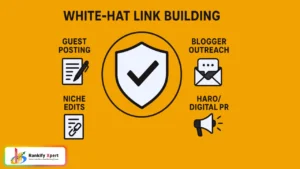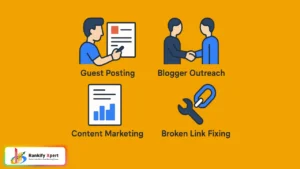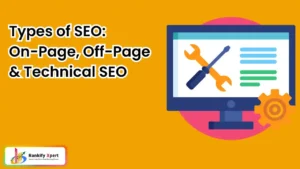Link building is a search engine optimization (SEO) technique that involves acquiring hyperlinks from other websites to your own. Think of these backlinks as digital votes of confidence – when reputable websites link to your content, search engines like Google interpret this as a signal that your webpage provides valuable, trustworthy information. This endorsement system directly impacts how search engines rank your pages in search results.
The importance of link building cannot be overstated. Research shows that 55.7% of SEO professionals consider backlinks a crucial ranking factor, and websites ranking first on Google have 3.8 times more backlinks than other top-10 results. However, with 94% of content on the internet never receiving any backlinks, building quality links requires strategic effort and ethical practices.
Table of Contents
ToggleWhite Hat vs Black Hat Link Building
The link building landscape divides into three distinct approaches: white hat, gray hat, and black hat techniques. Understanding these differences is crucial for developing a sustainable SEO strategy.

White Hat Link Building represents the ethical, Google-approved approach to acquiring backlinks. This methodology focuses on creating genuine value for users and earning links through merit. White hat strategies include producing high-quality content, conducting original research, guest posting on relevant websites, and building authentic relationships within your industry. These techniques align with search engine guidelines and prioritize long-term results over quick wins.
Black Hat Link Building employs manipulative tactics that violate search engine guidelines. These methods include purchasing low-quality backlinks, using private blog networks (PBNs), participating in link farms, and automatically generating comment spam across multiple websites. While black hat techniques might deliver short-term ranking improvements, they carry substantial risks and often result in severe penalties.
Gray Hat Link Building occupies the middle ground between white and black hat approaches. These strategies aren’t explicitly prohibited but push the boundaries of acceptable practices. Examples include paying for links that appear editorial or engaging in reciprocal link schemes. Gray hat methods introduce unnecessary risk to your website’s long-term performance.
What Is White-Hat Link Building?
White hat link building is a search engine optimization technique for increasing the number of high-quality backlinks to a webpage using strategies that completely adhere to Google’s guidelines and webmaster quality standards. This ethical approach focuses on earning links naturally through merit rather than manipulating search engine algorithms through deceptive practices.
At its core, white hat link building revolves around creating genuine value for users and the broader online community. The methodology emphasizes building authentic relationships with other website owners, producing exceptional content that naturally attracts links, and engaging in legitimate promotional activities that enhance user experience. These strategies require more time and effort than shortcuts, but they deliver sustainable results that strengthen your website’s authority over time.
The fundamental principle behind white hat link building lies in editorial oversight and genuine recommendation. Links are considered white hat when they are placed in content after proper editorial review, serve a legitimate purpose for readers, and haven’t been influenced by direct payment or manipulation. This means the website owner linking to your content genuinely believes it will benefit their audience.
How White Hat Link Building Aligns with Google’s Guidelines
Google’s approach to link evaluation has evolved significantly since the search engine’s inception. The company now favors “organic” link building methods that enhance user experience by boosting content quality and broadening its scope through relevant, helpful links. Google’s updated guidelines specifically state that the best way to encourage others to create high-quality links to your site is to create unique, relevant content that can naturally gain popularity in the internet community.
This alignment with Google’s vision becomes evident when examining what the search engine considers valuable link signals. Google’s algorithms evaluate factors such as the referring website’s relevance to your content, whether the link placement appears natural within the context, and the overall trustworthiness of the linking domain. Websites that demonstrate expertise, authoritativeness, and trustworthiness (E-A-T) receive preferential treatment in link value assessment.
The search engine giant actively rewards websites that follow white hat practices through improved rankings and increased organic visibility. Google’s machine learning systems can identify patterns consistent with natural link acquisition, such as gradual growth over time, diverse anchor text usage, and links from topically relevant sources. These positive signals contribute to higher domain authority and improved search performance across your entire website.
Conversely, Google penalizes websites that violate its link guidelines through manual actions and algorithmic demotions. The search engine’s sophisticated detection systems can identify artificial link patterns, purchased backlinks, and manipulative schemes with increasing accuracy. Recovery from these penalties often requires months of remediation work and significant business disruption.
Why White-Hat Link Building Matters in SEO
White hat link building serves as the foundation for sustainable search engine optimization success, delivering multiple benefits that compound over time to strengthen your website’s overall performance and market position.
Builds Domain Authority & Trust
Domain authority represents your website’s overall strength and trustworthiness in search engine evaluation systems. Quality backlinks from reputable websites act as trust signals, demonstrating that established industry sources vouch for your content’s credibility and value. When authoritative websites link to your pages, search engines interpret this as evidence that your domain provides reliable, expert-level information.
This trust-building process extends beyond algorithmic evaluation to human perception. Users encountering links to your website on respected platforms develop confidence in your brand before even visiting your site. Research indicates that 74% of readers find content containing credible data sources more trustworthy, highlighting the importance of earning links from established, authoritative domains.
The cumulative effect of trust-building through white hat link building creates a protective barrier against negative SEO attacks and algorithmic fluctuations. Websites with strong trust profiles typically maintain stable rankings even during major search engine updates, as their established authority patterns signal legitimate value rather than manipulative optimization.
Improves Organic Rankings
The correlation between quality backlinks and improved search rankings remains one of the strongest signals in modern SEO. Websites ranking first on Google have 3.8 times more backlinks than other top-10 results, demonstrating the continued importance of link equity in ranking algorithms.
However, the ranking improvement from white hat link building extends beyond simple link quantity. Search engines evaluate contextual relevance, ensuring that backlinks from topically related websites carry more weight than unrelated sources. A single link from a highly relevant, authoritative website can provide more ranking benefit than dozens of low-quality or irrelevant backlinks.
The ranking improvements from white hat strategies also tend to be more stable and long-lasting. Unlike artificial ranking boosts from manipulative tactics, organic link growth creates sustainable ranking improvements that strengthen over time as additional quality signals accumulate.
Drives Referral Traffic from Real Websites
Beyond their SEO value, quality backlinks serve as traffic generation channels, directing engaged users from established websites to your content. This referral traffic often exhibits higher engagement metrics, including longer session durations, lower bounce rates, and higher conversion rates compared to other traffic sources.
The quality of referral traffic from white hat backlinks stems from the contextual relevance and editorial recommendation inherent in legitimate link placements. Users clicking these links already have demonstrated interest in related topics and trust the referring website’s judgment, making them highly qualified prospects for your content or services.
Referral traffic also provides valuable diversification for your overall traffic portfolio, reducing dependence on search engine organic traffic and creating multiple pathways for users to discover your website. This diversification becomes particularly valuable during algorithm updates or competitive shifts that might temporarily affect organic visibility.
Future-Proof Against Algorithm Updates
White hat link building strategies align with the fundamental direction of search engine evolution, making them inherently resistant to algorithm changes. As Google and other search engines become more sophisticated in detecting artificial manipulation, they increasingly reward signals that indicate genuine user value and editorial merit.
The future-proofing aspect of white hat link building derives from its focus on meeting user needs rather than exploiting technical loopholes. Since these strategies emphasize creating valuable content and building authentic relationships, they remain effective regardless of specific ranking factor adjustments or algorithm modifications.
Historical analysis of major algorithm updates reveals that websites following white hat practices typically maintain or improve their rankings, while sites dependent on manipulative tactics experience significant volatility. This pattern reinforces the long-term value of ethical link building approaches for maintaining competitive search visibility.
Key Strategies for White-Hat Link Building
Guest Posting
Guest posting involves creating high-quality content for publication on other websites within your industry or niche, typically including relevant backlinks to your own website within the article content or author bio. This strategy builds relationships with industry peers while demonstrating expertise to new audiences.

How Guest Posting Works:
The guest posting process begins with identifying reputable websites that accept external contributions and align with your target audience. Quality guest posting opportunities typically exist on sites with established readerships, regular publishing schedules, and editorial standards that ensure content quality.
Successful guest posting requires creating content specifically tailored to each target publication’s audience and editorial guidelines. The content should provide genuine value to readers while naturally incorporating relevant links to your website where they enhance the user experience or provide additional valuable resources.
Best Practices for Guest Posting:
Focus exclusively on niche-relevant, high-domain authority sites that serve your target audience. Tools like Ahrefs’ Content Explorer can help identify websites receiving substantial organic traffic for topics related to your expertise. Filter results to show sites with multiple authors, as this often indicates openness to guest contributions.
Prioritize quality over quantity by being selective about guest posting opportunities. A single guest post on a highly relevant, authoritative website provides more long-term value than multiple posts on lower-quality sites. Google specifically warns against “large-scale guest posting campaigns with keyword-rich anchor text links,” making selectivity crucial for maintaining white hat status.
Research each target website thoroughly before outreach, demonstrating familiarity with their content style, audience, and recent publications. Personalized pitches that reference specific articles or mention genuine appreciation for the site’s content achieve significantly higher acceptance rates than generic mass outreach.
Blogger Outreach
Blogger outreach involves identifying influential content creators and website owners within your industry and building relationships that naturally lead to backlink opportunities. This strategy emphasizes long-term relationship building over transactional link requests.
Personalized Outreach to Site Owners:
Effective blogger outreach begins with comprehensive research to identify bloggers and website owners who regularly cover topics related to your expertise. Tools like Ahrefs’ Site Explorer can reveal which websites link to your competitors, indicating potential outreach targets with demonstrated interest in your industry.
Personalization remains crucial for outreach success. Begin relationship-building by engaging with bloggers’ content through thoughtful comments, social media interactions, and genuine appreciation for their work. This foundation creates familiarity and trust before making any link-related requests.
Building Relationships for Natural Backlinks:
The most effective blogger outreach focuses on providing value before requesting anything in return. Share relevant industry insights, offer expert commentary on trending topics, or provide exclusive data that bloggers can reference in their content. This value-first approach often results in natural link placements without explicit requests.
Consider featuring links to bloggers’ content in your own articles, then informing them about the mention. This gesture demonstrates genuine appreciation for their work while introducing your brand in a positive context. Many bloggers reciprocate by exploring your content and potentially linking to relevant resources.
Niche Edits / Link Insertions
Niche edits involve adding relevant links to existing articles on established websites, placing your backlinks within content that already ranks well and attracts organic traffic. This strategy leverages the existing authority and relevance of published content.
Adding Links to Existing Relevant Articles:
The niche edit process begins by identifying high-quality articles that would benefit from additional resources or references related to your expertise. These opportunities often exist in comprehensive guides, resource lists, or articles that mention topics you cover extensively.
Successful niche edit placements require demonstrating clear value to the existing content. Your suggested link should fill an information gap, provide updated statistics, or offer additional depth on a topic already covered in the article. This approach ensures the link addition improves the user experience rather than appearing promotional.
Benefits of Contextual Placement:
Contextual link placement within established content provides several advantages over other link building methods. The links appear within content that already demonstrates topical relevance and authority, potentially increasing their value in search engine evaluation systems.
Existing articles often have established traffic patterns and ranking positions, meaning your backlinks can immediately benefit from ongoing organic visibility. This advantage contrasts with links in new content that must first achieve rankings and attract readers.
Content Marketing & Linkable Assets
Content marketing for link building involves creating exceptional resources that other websites naturally want to reference and share with their audiences. These linkable assets provide substantial value that makes them irresistible to content creators seeking comprehensive resources.
Creating High-Value Guides, Case Studies, or Infographics:
Linkable assets come in various formats, each serving different audience preferences and use cases. In-depth guides that comprehensively cover complex topics become go-to resources that industry professionals bookmark and reference repeatedly. Research shows that long-form content receives 77.2% more backlinks than shorter articles.
Original case studies and research reports provide unique data that journalists, bloggers, and content creators seek to support their own arguments. These assets often generate significant link volume as multiple websites reference the same compelling statistics or insights. For example, exclusive research on industry trends can attract links from dozens of relevant websites citing the same data.
Visual content like infographics and interactive tools often achieve viral distribution due to their shareability and accessibility. Data visualization that transforms complex information into digestible graphics appeals to content creators who want to enhance their articles with compelling visuals.
How Great Content Naturally Attracts Backlinks:
Exceptional content attracts backlinks through multiple mechanisms that extend beyond initial publication. Search engines surface high-quality resources in response to relevant queries, exposing your content to potential linkers who discover it through organic search.
Social media amplification expands your content’s reach exponentially, as shares and discussions introduce your resources to extended professional networks. Industry influencers who discover valuable content often reference it in their own publications, creating high-authority backlink opportunities.
Broken Link Building
Broken link building identifies non-functional links on authoritative websites and offers your relevant content as replacement resources. This strategy provides value to website owners by helping them maintain user experience while creating backlink opportunities.
Finding Broken Links on Authority Sites:
Tools like Ahrefs’ Content Explorer can identify broken pages that previously attracted substantial backlink volume. Filter for pages returning 404 errors with 10 or more referring domains to find replacement opportunities with proven link acquisition potential.
Focus on broken links within content that closely aligns with your expertise and available resources. The most successful broken link building targets situations where your content provides equivalent or superior value compared to the original broken resource.
Suggesting Your Content as a Replacement:
Approach website owners with helpful notifications about broken links, positioning yourself as providing valuable assistance rather than making promotional requests. Include specific information about the broken link’s location and suggest your content as a relevant replacement that serves their readers’ needs.
The key to successful broken link building lies in timing and presentation. Contact website owners promptly after identifying broken links, as delayed outreach may result in other replacement suggestions or reduced motivation to address the issue.
HARO (Help a Reporter Out) & Digital PR
HARO and similar services connect subject matter experts with journalists seeking sources for their stories, creating opportunities to earn backlinks from high-authority news and media websites.
Getting Links from News Websites, Journalists, and Media Mentions:
HARO sends daily emails containing journalist queries seeking expert input on specific topics. Successful HARO participation requires monitoring these queries for opportunities that align with your expertise and responding quickly with valuable, quotable insights.
The quality of HARO opportunities often exceeds other link building methods, as participating journalists typically work for established publications with high domain authority and substantial readership. Links from sources like Forbes, Business Insider, and industry trade publications provide exceptional SEO value and brand credibility.
Digital PR expands beyond HARO to include proactive media outreach, where you create newsworthy content or commentary and pitch directly to relevant journalists and publications. This approach requires developing media contacts and understanding what types of stories different publications typically cover.
White-Hat vs Black-Hat vs Gray-Hat Link Building
| Aspect | White Hat | Gray Hat | Black Hat |
| Google Compliance | Fully compliant with guidelines | Questionable compliance | Violates guidelines |
| Risk Level | Minimal risk | Moderate risk | High penalty risk |
| Longevity | Sustainable long-term | Potentially temporary | Often short-lived |
| Effort Required | High time investment | Moderate effort | Quick but risky |
| Link Quality | Editorial, contextual | Mixed quality | Often low quality |
| Examples | Guest posts, HARO, original research | Paid placements, reciprocal schemes | PBNs, link farms, spam comments |
| Results Timeline | Gradual, compound growth | Faster than white hat | Quick initial gains |
| Algorithm Resistance | Future-proof | Vulnerable to updates | High volatility |
Risks of Black-Hat Methods:
Private Blog Networks (PBNs) represent one of the most dangerous black hat tactics, involving networks of websites created solely to provide backlinks. Google’s algorithms have become increasingly sophisticated at identifying PBN footprints, often resulting in severe penalties that can eliminate websites from search results entirely.
Link farms and spammy directories offer bulk backlink opportunities but provide no editorial value or user benefit. These tactics not only risk penalties but also associate your website with low-quality neighborhoods that can damage overall domain authority and trustworthiness signals.
Automated comment spam and forum posting create thousands of low-value backlinks that search engines easily identify as manipulative. Recovery from penalties related to these tactics often requires extensive disavowal work and months of rebuilding trust with search engines.
Why Gray-Hat May Seem Tempting But Still Risky:
Gray hat strategies like purchasing editorial-style placements or engaging in reciprocal link schemes may appear safer than obvious black hat tactics, but they still introduce unnecessary risk to your website’s long-term performance. Google’s guidelines specifically discourage paying for links, regardless of how natural they might appear.
The challenge with gray hat approaches lies in their unpredictability. While some gray hat tactics might work temporarily, algorithm updates or manual review processes can retrospectively penalize these strategies, potentially affecting years of SEO progress.
Common Mistakes to Avoid in White-Hat Link Building
Focusing Only on Domain Authority, Ignoring Relevance:
Many link builders make the mistake of prioritizing domain authority metrics over topical relevance when evaluating link opportunities. While high-authority backlinks provide value, a relevant link from a moderately authoritative website often delivers better results than an irrelevant link from a high-authority source.
Search engines increasingly evaluate contextual relevance when assessing link value, meaning backlinks from topically related websites carry more weight in ranking calculations. Focus on building links from websites that serve similar audiences or cover related topics rather than simply pursuing the highest available domain authority.
Over-Optimized Anchor Texts:
Using exact-match keyword anchor text excessively can trigger algorithmic penalties or manual reviews. Natural link acquisition typically results in diverse anchor text patterns that include branded terms, generic phrases, and partial keyword matches rather than repetitive exact-match keywords.
Maintain anchor text diversity by encouraging natural linking patterns and avoiding excessive optimization. The most sustainable approach involves creating compelling content that naturally attracts varied anchor text as different websites describe and reference your resources in their own words.
Building Links Too Fast:
Rapid link acquisition can appear unnatural to search engines, particularly for newer websites or those with historically low backlink volumes. Sustainable link building follows organic growth patterns that gradually accelerate as your content library and industry relationships expand.
Focus on consistent, quality-focused link building rather than attempting to achieve quick volume increases. The most successful white hat campaigns build momentum over time, with each quality backlink potentially leading to additional organic link opportunities.
Ignoring Diversity in Link Sources:
Concentrating link building efforts on a single strategy or source type creates vulnerability to algorithm changes and reduces overall link profile strength. Diversified link building across multiple white hat strategies provides greater stability and comprehensive coverage of potential link opportunities.
Maintain diversity in link source types, including editorial mentions, resource page inclusions, guest post placements, and relationship-based links. This varied approach mirrors natural link acquisition patterns and provides resilience against changes in any single link building method’s effectiveness.
Measuring the Success of White-Hat Link Building
Tracking Backlinks with Ahrefs, SEMrush, or Google Search Console:
Regular backlink monitoring allows you to measure link acquisition progress and identify the most effective strategies within your white hat campaign. Tools like Ahrefs provide comprehensive backlink analysis, including new link discovery, link quality assessment, and competitive comparison features.
Google Search Console offers free backlink tracking directly from Google’s perspective, showing which links the search engine recognizes and values. This official data source provides authoritative insights into your link profile’s strength and growth patterns over time.
Set up automated monitoring to track new link acquisitions, lost links, and overall domain authority progression. Regular reporting helps identify successful outreach targets and content types that consistently attract quality backlinks.

Monitoring Organic Traffic Growth:
Link building success ultimately manifests through improved organic search visibility and increased website traffic from search engines. Monitor organic traffic patterns using Google Analytics, paying particular attention to traffic increases for pages that have received new backlinks.
Track organic traffic growth at both the page and site level to understand how individual link placements contribute to overall search performance. Pages receiving quality backlinks often experience improved rankings for multiple related keywords, expanding their total organic traffic potential.
Ranking Improvements for Target Keywords:
Monitor keyword ranking improvements for terms related to linked pages and overall website themes. Quality backlinks typically contribute to ranking improvements not just for targeted keywords but also for semantically related terms that search engines associate with your content topics.
Use rank tracking tools to monitor progress for both primary target keywords and long-tail variations that may benefit from improved topical authority. The compound effect of white hat link building often results in ranking improvements across broader keyword sets than initially targeted.
Referral Traffic Metrics:
Analyze referral traffic from backlink sources to understand the immediate value of link placements beyond SEO benefits. High-quality backlinks often drive engaged referral traffic that exhibits strong conversion potential and extended session durations.
Track referral traffic quality metrics including bounce rates, pages per session, and conversion rates to identify the most valuable link sources. This analysis helps prioritize similar opportunities and understand which types of backlinks provide the greatest overall business value.
Why Outsource White-Hat Link Building?
Challenges: Time-Consuming, Requires Expertise & Outreach:
White hat link building demands significant time investment across multiple complex activities including content creation, prospect research, relationship building, and ongoing campaign management. Most businesses lack the internal resources to execute comprehensive link building campaigns while maintaining other marketing priorities.
The expertise required for successful white hat link building spans multiple disciplines including content strategy, outreach copywriting, competitive analysis, and technical SEO knowledge. Building this expertise internally requires substantial training investment and ongoing skill development to keep pace with evolving best practices.
Effective outreach requires persistent follow-up, relationship maintenance, and personalized communication that many businesses find challenging to manage consistently. Professional link builders have established processes and dedicated time for these relationship-building activities.
Benefits of Hiring a Professional Agency:
Professional link building agencies bring established industry relationships that can accelerate campaign timelines and improve success rates. These existing connections provide access to link opportunities that might be difficult for businesses to identify or secure independently.
Agencies also provide specialized tools and technologies for prospect identification, outreach automation, and campaign tracking that represent significant investments for individual businesses. Access to premium SEO tools and proprietary databases enhances campaign effectiveness and efficiency.
Real Results from Professional Link-Building Campaigns:
Professional agencies typically demonstrate measurable results through case studies showing substantial improvements in domain authority, organic traffic growth, and keyword ranking improvements. These documented successes provide confidence in potential return on investment for link building services.
Experienced agencies also provide strategic guidance on integrating link building with broader SEO and content marketing initiatives, ensuring that link acquisition efforts support overall digital marketing objectives rather than operating in isolation.
Conclusion
White hat link building represents the foundation of sustainable SEO success, providing long-term ranking improvements while building genuine industry authority and brand recognition. The strategies outlined in this guide offer proven pathways to earning quality backlinks that strengthen your website’s search visibility and drive meaningful business results.
The investment in white hat link building pays dividends far beyond immediate SEO benefits. Quality backlinks continue providing value for years, creating compound returns that justify the initial time and resource investment required for ethical link acquisition. The relationships built through white hat outreach often develop into ongoing partnerships that support broader business objectives.
Most importantly, white hat link building future-proofs your SEO strategy against algorithm changes and competitive shifts. By focusing on genuine value creation and authentic relationship building, you create sustainable competitive advantages that strengthen over time rather than requiring constant maintenance or replacement.
Ready to grow with powerful, white-hat backlinks? Contact RankifyXpert today and let’s build your authority the right way. Our proven white hat link building strategies deliver sustainable results that protect your investment while driving measurable growth in organic traffic and search rankings.




